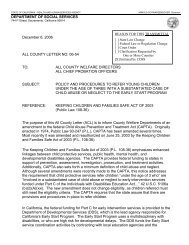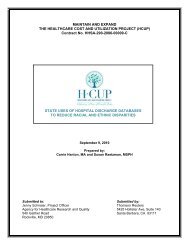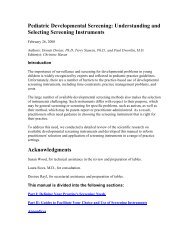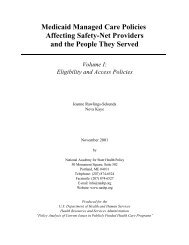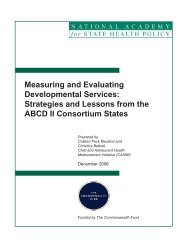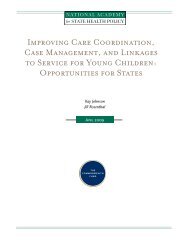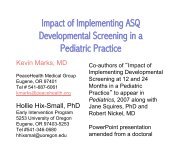Developing Federally Qualified Health Centers into Community ...
Developing Federally Qualified Health Centers into Community ...
Developing Federally Qualified Health Centers into Community ...
Create successful ePaper yourself
Turn your PDF publications into a flip-book with our unique Google optimized e-Paper software.
Lessons for States<br />
Develop a culture of collaboration. Montana Medicaid’s innovative approach was<br />
valuable in developing the FQHC-based care coordination model, and its collaborative<br />
relationship with the PCA was important in refining it. Montana is a small state in terms<br />
of population. Stakeholders report that, among the community of providers serving<br />
Medicaid beneficiaries, ―everyone knows everyone‖ and all share a strong sense of<br />
responsibility to serve them well. <strong>Developing</strong> collaborative relationships may prove more<br />
difficult in larger states.<br />
By bringing in the PCA as a strategic ally, Montana Medicaid was able to draw on<br />
its resources to facilitate meetings with FQHCs and provide feedback on draft program<br />
plans. Montana Medicaid also values the ability of the PCA to identify gaps in care<br />
processes.<br />
Be flexible and persistent. Montana Medicaid originally intended to pay FQHCs<br />
for serving as HIP sites through a cost-based reimbursement process. When CMS did not<br />
approve of this payment method, Montana shifted its approach to a per member per<br />
month fee. It took Montana Medicaid about one a year of negotiating with CMS to arrive<br />
at a mutually acceptable payment method.<br />
Serve the right clients. Care management is more valuable for some Medicaid<br />
beneficiaries than for others, and there are some concerns whether HIP is reaching the<br />
population most likely to benefit from the services. Montana Medicaid staff note that<br />
some clients are hard to reach, and that HIP does not serve Medicaid beneficiaries who<br />
are also eligible for Medicare. Such ―dual eligibles‖ often have a variety of medical and<br />
social needs that effective care management could address. Yet because these individuals<br />
are not included in the state’s Passport waiver, they are not eligible for HIP. Including<br />
them would require additional negotiations with CMS.<br />
Obtain maximum federal financial participation. Under its previous disease<br />
management contract, Montana Medicaid was able to obtain the full federal matching<br />
rate for services. Under HIP, the state receives the full rate for the $3.75 per member<br />
per month payments to health centers. But other expenses—including the costs of<br />
staff time, travel, printed materials, and predictive modeling software—receive federal<br />
funding at the lower administrative federal matching rate. To maximize federal funding,<br />
a state Medicaid program could conceivably increase the amount of the per member<br />
per month rate paid to sites and, in turn, require each site to pay a share of program’s<br />
administrative costs.<br />
10



